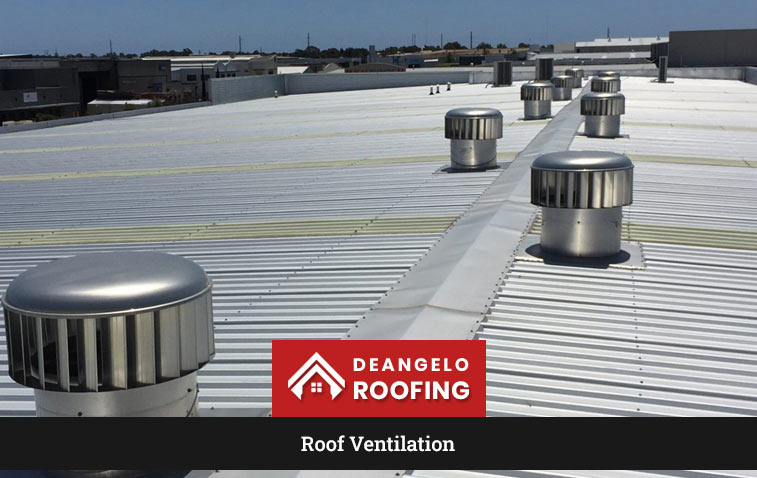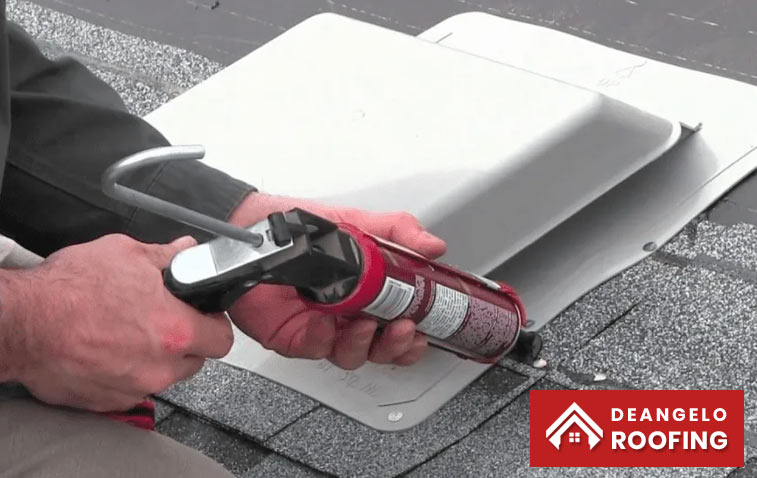Roof Ventilation: Why It’s Crucial for Roof Longevity and Indoor Comfort
The roof is one of the most important parts of any home. It protects from the outside elements and helps to maintain a comfortable indoor environment. Many homeowners may not realize that proper roof ventilation system plays a key role in the health of both the roof and the living spaces beneath it. Understanding why roof ventilation is crucial for both roof longevity and indoor comfort is important.

The Basics of Roof Ventilation
Roof ventilation is a system that allows air to flow in and out of the attic or roof space. It typically involves a combination of intake vents, which allow cool air to enter the attic, and exhaust vents, which allow hot, moist air to escape.
How Roof Ventilation Works
- Intake Vents: These vents are usually located at the lower parts of the roof, such as the eaves or soffits. They allow cooler, outside air to enter the attic space.
- Exhaust Vents: Located near the roof’s peak, exhaust vents allow the hot, humid air that has risen to the top of the attic to escape. This creates a continuous flow of air through the attic, which is crucial for maintaining a balanced temperature and moisture level.
Types of Roof Ventilation Systems
- Ridge Vents: These are installed along the peak of the roof and are a popular choice because they provide even ventilation across the entire roof.
- Soffit Vents: Located under the eaves, these vents are often used in combination with ridge vents to ensure proper air circulation.
- Gable Vents: Positioned at the gable ends of the house, these vents allow hot air to escape from the attic.
- Powered Vents: These are mechanical vents that use a fan to actively pull air out of the attic. They are useful in situations where natural ventilation is insufficient.
Implementation Tips:
- Balance Intake and Exhaust: To work effectively, the ventilation system must have a balance between intake and exhaust vents. Too much of one without the other can disrupt airflow.
- Ensure Clear Airflow: Make sure that insulation or other obstructions do not block vents. Clear, unobstructed airflow is essential for proper ventilation.
- Consult a Professional: If you are unsure about your roof ventilation needs, consider consulting with a roofing professional who can assess your attic and recommend the best ventilation system for your home.
Why Roof Ventilation is Essential for Roof Longevity
Proper roof ventilation system is a critical factor in extending the life of your roof. Without adequate ventilation, several issues can arise that contribute to the premature aging and deterioration of the roof.
Preventing Heat Damage in Summer
During the summer, temperatures in an unventilated attic can soar to extreme levels, sometimes reaching up to 150°F or more. This excessive heat can cause several problems:
- Shingle Deterioration: High temperatures can cause the shingles on your roof to age prematurely. The heat can cause them to dry out, crack, and become brittle, reducing their ability to protect your home.
- Warping of Roof Structure: The intense heat can also affect the structural components of the roof, such as the rafters and decking. Over time, these materials can warp or weaken, compromising the roof’s integrity.
Reducing Moisture Build-Up in Winter
In the winter, an unventilated attic can trap warm, moist air rising from the living spaces below. This moisture can lead to several issues:
- Condensation: When warm, moist air hits the cold surfaces of the roof decking, it can condense into water. Over time, this moisture can lead to the growth of mold and mildew, which can damage the roof structure and insulation.
- Ice Dams: Poor ventilation can also contribute to the formation of ice dams. Ice dams occur when snow on the roof melts due to heat escaping from the attic and then refreezes at the roof’s edge. This can cause water to back up under the shingles, leading to leaks and damage.
Implementation Tips:
- Check for Hot Spots: Inspect your attic during the summer to see if there are areas where heat is building up. This can indicate that your ventilation is inadequate.
- Monitor for Moisture: Look for signs of moisture in the attic during the winter, such as damp insulation or condensation on the rafters. This can help you identify ventilation issues before they cause serious damage.
- Regular Roof Inspections: Schedule regular roof inspections to catch any ventilation-related issues early. This can prevent costly repairs and extend the life of your roof.
Impact of Roof Ventilation on Indoor Comfort
Roof ventilation not only protects your roof but also plays a vital role in maintaining indoor comfort. Proper ventilation can help regulate indoor temperatures, improve air quality, and reduce energy costs.
Temperature Regulation
A well-ventilated attic prevents the buildup of heat in the summer, which can have a significant impact on indoor comfort:
- Cooler Indoor Temperatures: By allowing hot air to escape from the attic, roof ventilation helps keep the entire house cooler. This reduces the strain on your air conditioning system and helps maintain a comfortable indoor temperature.
- Reduced Hot Spots: Proper ventilation helps to distribute heat more evenly throughout the house, reducing the occurrence of hot spots in rooms directly below the attic.
Improved Air Quality
Good roof ventilation also contributes to better indoor air quality:
- Prevents Stale Air: Without proper ventilation, air in the attic can become stale and stagnant. This can lead to poor air quality in the living spaces below.
- Reduces Mold and Mildew: By preventing moisture buildup, ventilation helps to reduce the risk of mold and mildew growth, which can have serious health implications for the home’s occupants.
Lower Energy Costs
Effective roof ventilation can also help to lower energy costs:
- Reduced Cooling Costs: By keeping the attic cooler in the summer, ventilation reduces the need for air conditioning, leading to lower energy bills.
- Improved Insulation Performance: Proper ventilation helps insulation work more effectively by preventing moisture buildup that can reduce its insulating properties.
Implementation Tips:
- Assess Indoor Comfort: Pay attention to how comfortable your home feels during different seasons. If you notice temperature fluctuations or poor air quality, it may be worth evaluating your roof ventilation.
- Energy Audit: Consider conducting an energy audit to assess how well your roof ventilation system is contributing to energy efficiency. This can help you identify areas for improvement.
- Keep Vents Clear: Ensure that vents are not blocked by insulation, debris, or other obstructions that could hinder airflow and reduce the effectiveness of the ventilation system.
Long-Term Benefits of Proper Roof Ventilation System
Investing in proper roof ventilation offers long-term benefits that go beyond roof longevity and indoor comfort. These benefits can enhance the overall value of your home and contribute to a healthier living environment.
Increased Roof Lifespan
One of the most significant long-term benefits of proper roof ventilation is the extended lifespan of your roof. By preventing heat and moisture-related damage, ventilation helps to ensure that your roof remains in good condition for many years, reducing the need for premature replacement.
Reduced Maintenance Costs
Proper ventilation can also lead to reduced maintenance costs over the life of your roof:
- Fewer Repairs: By preventing issues such as shingle deterioration, warping, and mold growth, good ventilation reduces the likelihood of needing costly repairs.
- Longer-Lasting Insulation: Ventilation helps to protect insulation from moisture damage, ensuring that it remains effective for longer and reducing the need for replacement.
Improved Home Value
A well-ventilated roof can enhance the value of your home:
- Energy Efficiency: Homes with good roof ventilation are more energy-efficient, which can be a selling point for potential buyers.
- Healthier Living Environment: By preventing mold and mildew growth, proper ventilation contributes to a healthier indoor environment, which is another attractive feature for buyers.
Implementation Tips:
- Plan for the Long-Term: When assessing your roof ventilation needs, consider the long-term benefits and invest in a system that will provide lasting protection for your roof and home.
- Regular Maintenance: Keep up with regular maintenance of your ventilation system to ensure it continues to function effectively over the years.
- Document Improvements: If you upgrade your roof ventilation system, keep records of the improvements. This can be useful if you decide to sell your home in the future, as it demonstrates a commitment to proper home maintenance.
Proper roof ventilation system is essential for a healthy home. Many homeowners don’t know that proper roof ventilation is essential for both the roof and the rooms below. Roof ventilation helps control temperature and moisture in the attic, stopping heat buildup in summer and moisture in winter. Without good ventilation, roofs can wear out faster, and indoor comfort can suffer. Knowing the importance of roof ventilation can help homeowners protect their homes and maintain a comfortable living space all year.
FAQs
You can tell if your roof has enough ventilation by checking for signs such as hot spots in your attic during summer, moisture buildup, or the presence of mold or mildew. If you’re unsure, consider having a professional inspect your attic and ventilation system.
Signs of poor roof ventilation include high indoor temperatures, uneven heating or cooling, increased energy bills, damp or musty smells in the attic, and visible mold or mildew. If you notice any of these issues, your roof ventilation may need improvement.
Yes, proper roof ventilation can help reduce energy costs by regulating indoor temperatures and reducing the need for air conditioning in the summer. It also helps your insulation work more effectively, which can lower heating and cooling costs.
The best types of vents for roof ventilation include ridge vents, soffit vents, and gable vents. The choice depends on your roof’s design and specific ventilation needs. A combination of intake and exhaust vents is often most effective for balanced airflow.

